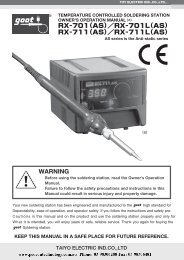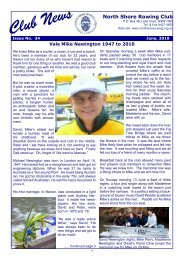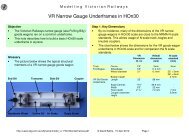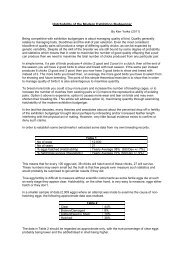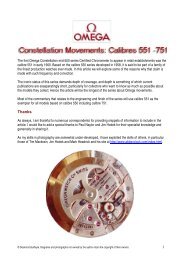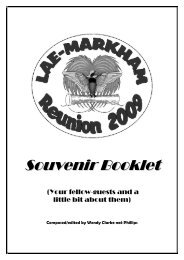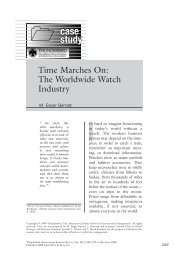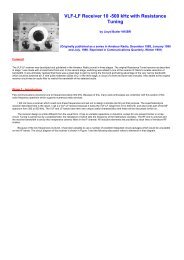A Case Study
A Case Study
A Case Study
Create successful ePaper yourself
Turn your PDF publications into a flip-book with our unique Google optimized e-Paper software.
A <strong>Case</strong> <strong>Study</strong><br />
1
Hidden crown case 168.004 sporting a poorly refinished dial and calibre<br />
751 movement - caseback number should be 168.016<br />
During the period of in-house manufacture of Omega<br />
Constellations – from the 300 series calibres through<br />
to and including some of the 1000 series calibres –<br />
more than 300 model numbers were released, of<br />
which about 200 are listed on the Omega database.<br />
Fortunately for the collector, while there were<br />
numerous models the case styles and designs<br />
remained relatively few. In this article I will cover<br />
cases from a design perspective, rather than repeat<br />
what is on the Omega database. Where possible I will<br />
introduce information that is not on the database.<br />
This article covers men’s Constellations from<br />
inception to the end of in-house manufacture. True Inhouse<br />
manufacture ended, it is argued, when<br />
Nicholas Heyek first re-structured the SSIH Group,<br />
although it has been claimed that Omega has always<br />
maintained its ‘manufacture’ status because most of<br />
the watch components have always been produced<br />
within the Swatch corporate stable of which Omega is<br />
a part.<br />
<strong>Case</strong> back Numbers<br />
<strong>Case</strong> back numbers are very important because they<br />
allow you to match the case style and approximate<br />
period of manufacture with the serial number of the<br />
movement. They are a key to comprehensive<br />
information about particular Constellation models.<br />
For example, if you were investigating the possibility<br />
of purchasing a hidden crown Constellation with a<br />
35.5mm case, numbered 168.004, that featured a<br />
convex deluxe dial, a search of the Omega database<br />
http://www.omegawatches.com/cu_vintage/main.php<br />
will reveal information shown in the table opposite.<br />
The information reveals the calibre number of the<br />
movement housed in this case, dial features,<br />
movement functions and other important information<br />
that is invaluable in determining authenticity or<br />
originality of the watch.<br />
What this particular listing doesn’t tell you is the<br />
number of the case that superseded this model. For<br />
that you would have to dig deeper into the database<br />
to determine that, in this instance, the replacement<br />
cases were 168.0010 and later still, 168.016<br />
2
So, if you discovered a calibre 751 movement sitting in a case<br />
168.004 instead of case 168.016 as in the example overleaf,<br />
you would be alerted immediately to the work of a rather<br />
perverted Doctor Frankenwatch!<br />
Crowns<br />
The most famous of the Constellation crowns were the ‘tensiders’<br />
used in the 1950s and earlier 60s models. BF 1080<br />
(2.00mm tube diameter) has now been discontinued while BF<br />
1060 (2.5mm tube diameter) is still available as at 2007.<br />
The standard for all Constellation watches until ref. 168.004 and<br />
the C-Shaped cases is the ten-sided crown with the reference<br />
numbers mentioned above. Omega has since substituted a<br />
round crown for the discontinued ten-sider, however, to repeat,<br />
all case numbers to 168.004 originally featured a ten-sided<br />
crown.<br />
Correct crowns are determined by case back numbers. One<br />
way in which to establish if the crown on your Constellation<br />
meets specifications is to access the web pages of jewellery<br />
supplier Otto Frei: http://www.ofrei.com/page_147.html<br />
While, from some accounts, the people at the Otto Frei<br />
establishment are not the most pleasant of people to deal with,<br />
the web site is a mine of information. Use the search function<br />
(enter, for example, “2943 crown”) and you will be directed<br />
quickly to the part number that matches the case back number.<br />
In many instances there are photographs of the crown, which<br />
enable you to ascertain visually if a crown is correct.<br />
<strong>Case</strong> Condition<br />
The best measure of case condition is sharpness of lines. As<br />
mentioned later, the pre dogs-leg cases made quite an<br />
aggressive design statement with strong definition and distinct<br />
lines. This statement is forever compromised when zealous or<br />
dim-witted restorers decide to give the case a “bit of a polish”<br />
and don’t know when to stop.<br />
Example of overzealous polishing that removes the original<br />
case finish. In this case, the vendor effectively sliced US200.00<br />
off the value of the watch<br />
<strong>Case</strong> 2853 solid gold case Calibre 501: Note wear around bezel<br />
and lugs caused by over-polishing.<br />
Earlier Constellations were highly polished. Any polishing out of marks and dings should maintain strictly the<br />
distinct symmetry of the case. Many dealers and watchmakers make the mistake of polishing the life out of<br />
cases, leaving them bereft of their original character. Later Constellations often featured satin or brushed<br />
finishes, and, once again, zealous polishers often eliminate the original finish in an attempt to remove signs of<br />
wear and tear, as per the example above top.<br />
From a collecting point of view, a sharp case with a few surface scratches and minor dings is preferable to an<br />
overly polished one that has been transformed into a soulless shell devoid of its original charm. When<br />
examining a case with a view to purchase, either avoid cases that have lost their definition through wear or<br />
over-polishing or discount the price accordingly.<br />
3
Contrary to popular belief, the stainless steel used for Omega<br />
watch cases, as with most other brands, will rust over time.<br />
Moisture enters a watch essentially in three places: through the<br />
crystal or bezel, through the crown stem and through the case<br />
back. When moisture enters, the affected parts may remain moist<br />
for days and the ultimate result is rust. Bad case back gaskets<br />
appear to the major cause of rust in Omega cases, the hermetic<br />
crowns offering good protection. In the example appearing<br />
opposite, the gasket had almost completely degraded leaving a<br />
long-unserviced watch to rust over time.<br />
Untreated rust, or watch cases pitted by rust can be a good<br />
indicator of a neglected watch. Often the rust spreads to the case<br />
clamps and movement, and, while rust can be treated, it cannot<br />
be removed. Collectors who do not repair their watches would<br />
do best to avoid rusty cases because they’re often symptomatic<br />
of rusted movement parts.<br />
There are comparatively few parts of a case, and for the sake of convenience they and other relevant terms<br />
are listed below:<br />
<strong>Case</strong>: The metal housing of a watch's parts that protects the watch-movement from dust, damp and shocks.<br />
Bezel: The retaining ring in which the crystal or glass is mounted.<br />
Middle: The middle of most 300 and 500 series Constellations is the circular part of the case that plumps out from the bezel.<br />
Later Constellations featured one-piece cases (monocoques) with a different water and moisture resisting system. The<br />
movement was accessed through the front of the case after removal of the crystal.<br />
<strong>Case</strong> back: The reverse side of a watch case. Constellation case backs either have a solid gold observatory decal or a stainless<br />
steel observatory decal moulded into the case back. <strong>Case</strong> backs are mainly ‘screw-in’ (The case back and gasket/o ring screws<br />
into the middle case affording a watertight fit) or press-in (The case back snaps on to the middle case when pressure is applied,<br />
which, according to some, does not afford as good a seal).<br />
Beads of Rice: Seven and nine row bracelets that featured smaller inner links that resembled beads of rice.<br />
Bevelling : Chamfering of the edges of the bezel to create additional ‘lines’ to the watch case.<br />
Brushed Finish: A non-gloss polished finish, akin to brushed metal finishes. Some horological vandals use a smooth polish on<br />
brushed finished surfaces to remove signs of wear from the watch. This devalues the watch considerably.<br />
Crown: The knob on the pendant of a stem, turned to wind the watch and to set the hands and date.<br />
Crystal: Also known as the ‘glass’ that covers the dial. Many earlier Constellations have acrylic crystals that mark and scratch<br />
with normal daily wear. Shallow scratches can be buffed out. Later Constellations featured a mineral crystal that is more<br />
resistant to scratching.<br />
Ebauche: French term also used in English speaking countries to describe a movement blank: basically a collection of loose<br />
parts including the plate, bridges, the power train, winding and setting mechanism and the regulator. The timing system, the<br />
escapement and the mainspring, however, are not parts of an "ébauche".<br />
Gold Top: A term used to describe Omega cases with a solid gold bezel and 100 micron rolled gold/gold plaque lugs.<br />
Integrated bracelet: A bracelet that is incorporated into the design of the case.<br />
Lugs: Protrusions on the case of a watch to which the bracelet or strap is fitted. Various types of lugs can be found on<br />
Constellations, such as teardrop lugs, straight lugs, Bombay-type lugs and what are known as ‘dog leg’ lugs.<br />
Manufacture d'horlogerie: French term for a company which produces most of the components (particularly the "ébauches")<br />
needed for the manufacture of its models. Usually shortened to ‘manufacture’<br />
Monocoque: French term that literally means single, or one, shell: in other words a one-piece case where the movement is<br />
accessed through removal of the crystal.<br />
O-Ring: Also known as gasket. Used to seal the back of the watch both in press-in or screw-on models. Usually also used on<br />
the winding stem to protect against water and dust. Normally made from rubber or plastic<br />
Spring bar: A small rod with a sprung pivot at either end to fix the strap or bracelet to the case.<br />
4
Chapters of the Constellation Design Story<br />
There were three distinct case design chapters in the history of<br />
true ‘manufacture’ Omega Constellations. The First Chapter<br />
began in 1952 and lasted until 1958 when the sturdy old cal 354<br />
Bumper was finally phased out in favour of the Calibre 501 bidirectional<br />
rotor movement.<br />
The first chapter is represented splendidly by case 2700<br />
shown in the picture opposite, taken from the Omega website.<br />
The first ever cases to house a branded Omega Constellation<br />
were the 2648 series, however all of these were fitted with<br />
convex rather than pie pan dials. The series was released in<br />
1952 and offered a choice of solid gold, gold cap or stainless<br />
steel cases. The 2700 was the first of the pie pan dials and<br />
featured arrow-head markers, a ten sided crown and a firm<br />
curve on the outer plane of the lugs. The lugs had open spring<br />
bar holes that allowed easy removal of bands and bracelets.<br />
The cases were not water resistant and the 2652 was soon<br />
released to correct that shortcoming. For those wanting to<br />
collect models that were released from 1952, the cases to<br />
collect are: 2648, 2652, 2699 & 2700 (Deluxe). These cases<br />
were marketed for about two years in Europe, but longer<br />
internationally. The grand Luxe model 14355 was launched in<br />
1953, and in 1954 upgrades of the earlier models offering better<br />
waterproofing and additional dial designs were represented by<br />
cases 2782 and 2799. <strong>Case</strong> 2652 was still being sold in 1957<br />
as I have seen as original sales docket for the model dated so.<br />
The cases were robust-looking with larger bezels that included<br />
a strongly bevelled rim. In the example above, the bezel is of<br />
solid rose gold and the heavy lugs are covered with a 100micron<br />
layer of gold, known as “rolled gold” or “gold plaque”.<br />
The ten-sided crown was in gold plate and contrasted<br />
beautifully with the polished stainless steel body of the case.<br />
The stainless steel middle of the case plumped out from the<br />
bezel.<br />
The examples on this page demonstrate how the pre dogs-leg<br />
cases offered quite an aggressive visual statement about the<br />
status of the watch, achieved through a rapport between the 12<br />
facets of the pie pan dial, the heavy hour markers, a deeply<br />
chamfered bezel edge and strong Bombay-type lugs.<br />
<strong>Case</strong> numbers for the Calibre 352 and 354 Constellations were<br />
in the 2xxx series. The Grand Luxe case back numbers<br />
however sported numbers in the 14xxx range, 14355 being the<br />
first Grand Luxe released. Deluxe versions in this calibre were<br />
2699 (screw-in), 2700 (press-in) and 2799 (press-in).<br />
<strong>Case</strong> OT 2700 – Very early Constellation Pie Pan - Calibre 354<br />
<strong>Case</strong> back 2652 Calibre 354 bumper movement. Note<br />
the condition of the case: sharp, unworn lines<br />
Seamaster <strong>Case</strong> 2577, calibre 354 with refinished<br />
Constellation dial<br />
5
<strong>Case</strong> numbers were few, and this is an important point to remember, as evidenced by the Frankenwatch<br />
calibre 354 Seamaster overleaf masquerading as a Constellation. The case housed only Seamasters, but also<br />
other models in the Omega range and is often seen bearing Constellation dials.<br />
<strong>Case</strong> 2699, calibre 354 Geneva Observatory, rare <strong>Case</strong> 2782 calibre 354 beautifully aged dial<br />
<strong>Case</strong> 2799 two-tone guilloche dial calibre 354<br />
<strong>Case</strong> 2652 SC solid gold, original dial, calibre 354<br />
6
Between 1955 and 1957 the 501, 504 and 505<br />
calibres were launched, and they can be seen as a<br />
bridge between the old and new design story.<br />
Fashions change and case and dial designs reflect<br />
changing tastes, however the late fifties weren’t<br />
notable for innovative case design. While a range of<br />
consumables including cars and furniture underwent a<br />
design revolution, initial 500 series case designs, and<br />
indeed some early calibre 551s, borrowed heavily from<br />
the earlier design slate, both in case style and dial<br />
appearance.<br />
The chunkier 35mm cases remained, the lugs were<br />
similarly curved and earlier models featured the open<br />
spring bar holes. <strong>Case</strong> 2852, for example can be seen<br />
with and without spring bar holes, although 18k<br />
models do not appear to have had spring bar holes.<br />
The lugs on the model opposite also look as though<br />
they taper more closely into the case at the bezel end,<br />
but in fact they do not and are very similar to the OT<br />
2700 illustrated previously.<br />
Markers were still, generally, quite solid, and earlier<br />
2xxx series cases, as with the earlier 300 series, some<br />
case backs were of the press-in, non waterproof<br />
variety.<br />
The early 500 series movements also borrowed from<br />
earlier technology, having been an evolution of the<br />
calibre 490, with added jewels and swan neck<br />
regulation to achieve better functionality and<br />
chronometer status.<br />
501, 504 and 505 case backs also generally sported<br />
case back numbers in the 2xxx range including:<br />
calibres 501/505 - cases 2852, 2853 and 2930 for the<br />
deluxe Pie pan, OG 2930 for the Grand Luxe, and in<br />
calibre 504: 2943, 2954, 2988 (Grand Luxe without<br />
bracelet) and 16995 for the Grand Luxe with bracelet.<br />
Chapter Two of the Constellation design story really<br />
began with the later calibre 551 and 561 case designs.<br />
The variety of case styles available grew. Dial designs<br />
changed with markers becoming less heavy, but the<br />
distinctive twelve-facet pie pan dial continued.<br />
The pie pan design has stood the test of time and<br />
appeared on a special Constellation model released in<br />
the mid-seventies, Seamaster models in the midseventies<br />
and resurfaced again in 2003 on some<br />
models of Geneve.<br />
<strong>Case</strong> 2943 5 SC Gold Top 35mm - Calibre 504 with deluxe convex dial.<br />
Identical to case 2852<br />
Side view of above case showing heaviness of lugs and teardrop<br />
shaping at ends<br />
<strong>Case</strong> 2852 solid gold – calibre 505<br />
7
German advertisement featuring case 2954 calibre 504 calendar models: note the change of hour markers from arrowhead to onyx inlaid faceted<br />
markers<br />
8
<strong>Case</strong>s similar to that of the 2xxx series were<br />
still housing Constellations up until the midsixties.<br />
The earlier calibre 551s were<br />
housed in cases in the 14xxx range until the<br />
case number system changed in around<br />
1963. The rule generally applies to the<br />
earlier calibre 561 date models as well.<br />
In 1964, case 14393 and similar styles were<br />
sold alongside the distinctive dog-leg lug<br />
cases featuring a finer, rounded bezel lines,<br />
rather than sharply chamfered, that first<br />
appeared in 14900 cases. Later replaced by<br />
case number 167.005/168.005, the dog-leg<br />
case design has remained one of the most<br />
popular designs with collectors.<br />
In the early 1960s, Omega broadened the<br />
range of case styles and dial designs and<br />
included an array of accessories that were<br />
marketed at sale point. This was one of the<br />
earlier attempts of multiple selling at the<br />
retail end, providing customers with a<br />
variety of options to ‘style up’ their<br />
purchase.<br />
The range of solid gold, gold plated,<br />
stainless steel and leather bands increased,<br />
and in many instances watchmakers<br />
purchased the watch heads and gave<br />
customers the option of band or bracelet<br />
choice. Some of the bracelets were<br />
exquisite. The four-ribbed bracelet<br />
appearing on a solid gold case similar to<br />
that pictured above – reference number BA<br />
3685415/886 on the 1964 pamphlet<br />
opposite – was simply stunning and is now<br />
quite rare.<br />
New styles featuring round cases with both<br />
hidden and non-hidden crowns came out in<br />
the date model 561 under the case number<br />
168.004. One of the first models to include<br />
an integrated bracelet was the 168.004 style<br />
case. Reference 368.5470/168.014<br />
incorporated a solid gold mesh bracelet<br />
welded to the watch head to stunning effect.<br />
The 168.004 case style continued as a<br />
popular choice until the early 1970s.<br />
Solid Gold Grand Luxe <strong>Case</strong> 14399 with hooded lugs - Calibre 551, with solid<br />
gold brickwork bracelet<br />
Good example of a 14393 ‘Gold Top’ case with calibre 561 movement, with incorrect<br />
second hand<br />
9
<strong>Case</strong> BA 368.802 Grand Luxe 18k solid gold. Calibre 561<br />
<strong>Case</strong> 14399 Grand Luxe 18k solid gold. Calibre 551<br />
<strong>Case</strong> 168.005. Late 1960s calibre 564. Excellently preserved convex dial. Note that date surround has bevelled round<br />
corners but non-bevelled horizontal planes<br />
10
Authentic version of the recently copied case 14900 SC 61 - calibre 551<br />
C- Shaped 168017 18k gold case, dial and bracelet – calibre 561<br />
Rarer <strong>Case</strong> 168.001 – 37mm case made especially for Japan,<br />
Singapore, Thailand and Indonesia. Same shape as the 14393 SC<br />
<strong>Case</strong>back 14381/2 SC-9 1959/60 calibre 551 18k solid gold<br />
11
<strong>Case</strong> 168.006: The deluxe, solid gold, Calibre 561 model with onyx inlaid markers. <strong>Case</strong><br />
168.005 housed the normal Pie pan dial with faceted markers, while case 167.005 housed<br />
the non-date calibre 551 movement<br />
<strong>Case</strong> 167.021. Calibre 712 serial number dates the watch to 1966. According to Omega<br />
the replacement for 167.005. Has screw-in case as opposed to normal 712 press-in case<br />
12
As the values of 1960s Pie pans increase so does the<br />
potential for fakes. A character on eBay was offering<br />
fake case ensembles such as the example shown<br />
opposite. The case number on all current fake cases<br />
offered is 14900 62 SC, and the astute collector will<br />
avoid the case number until confirming it is genuine.<br />
One way of confirming a genuine case is patina and<br />
other signs of normal wear, along with dial script<br />
confirmation, movement calibres and serial numbers.<br />
Numerous dealers have purchased these fake<br />
ensembles and a steady trickle of Frankenwatches has<br />
ensued on eBay and other markets as a result.<br />
Fake ‘solid gold’cases made in Thailland, Vietnam and<br />
China have also reached the market, the most common<br />
of which is a case with the case back number 091919.<br />
In around late 1964 Omega tested the C-Shape<br />
Constellation in the European market, so named<br />
because of mirror images of two Cs seen when viewing<br />
the case head-on. <strong>Case</strong> 168.009/17 in solid gold with a<br />
solid gold dial and bracelet was a sensation. The case<br />
also came in gold top and stainless steel models and<br />
remained as a staple of the line well into the 1000<br />
series movements.<br />
A range of C-Shaped cases with different dials followed,<br />
including calibre 561 powered 168.009/17 with gold<br />
hands and markers as well as the solid gold version of<br />
this case. C-Shaped models powered by calibre 564<br />
include the 1966 white gold knurled bezel model<br />
168.027 along with solid gold, stainless steel and gold<br />
top models of the same case number, and cases<br />
bearing the number 168.039 from the late 1960s.<br />
Some changes were effected in later cases, such as the<br />
knurled gold bezel in later 564 calibre examples and the<br />
calibre 751 day-date models. But, it is a testament to<br />
the excellent design of the case that it withstood the<br />
eclecticism and fickleness of ‘Swinging Sixties’ fashion<br />
preferences to survive into the Seventies.<br />
As in the earliest Constellation cases, some<br />
Constellation cases were not dissimilar to Seamaster<br />
and other Omega model cases, particularly some<br />
149xxx cases, and this is where the buyer needs to be<br />
wary. Often, a perfectly respectable, albeit nonchronometer<br />
grade 500 series Seamaster movement<br />
and case crops up wearing a Constellation dial. <strong>Case</strong><br />
numbers accessible through the Omega database<br />
become all-important.<br />
Solid Gold hidden crown model case 168.004/14 SC 62 Calibre 561<br />
<strong>Case</strong> 168.018. Late 1960s replacement for 168.004/168.0010. Nonhidden<br />
crown version with calibre 564 movement: Notice stick hands<br />
and onyx inlaid markers 13
The Omega database, however, is not complete, and<br />
many Constellation case numbers are not listed. In<br />
this instance, it is wise to seek expert help in<br />
establishing authenticity of the dial, movement, crown<br />
and case ensemble before committing to a purchase.<br />
The last of the Second Chapter Constellations were<br />
seen in cases 168.015 and 168.025, as shown<br />
opposite. The flat dial model came in case 168.015<br />
and featured gold hour markers and hands. The Pie<br />
pan model, 168.025, does not yet feature on the<br />
Omega database, and sported gold hands and gold<br />
onyx inlaid markers. The bezel of monocoque cases<br />
was highly polished, with brushed finish lugs.<br />
Monocoque cases were the replacement for cases<br />
168.005 and 168.006 solid gold Constellations. The<br />
movement is accessed through the use of a special<br />
tool to remove the bezel and crystal, and then by<br />
removing the crown and outer stem the movement can<br />
be taken from the case.<br />
The calibre 751 movement introduced in 1966/67<br />
signals an initial transition between the Second<br />
Chapter and the Third Chapter of Omega case design.<br />
Integrated bracelets and the move to what I call the<br />
‘Haute Bling” styles of the Seventies proper, when<br />
cases grew chunkier, heavier and larger than the<br />
simple elegance of the 34-35 mm case designs of their<br />
predecessors, signalled The Third Chapter proper.<br />
As in the early 500 calibres, Omega proceeded<br />
cautiously with the initial 751 designs. In 1967, C-<br />
Shaped 168.019 and 168.029 (knurled bezel) and<br />
168.016 the successor to 168.004, cases were the first<br />
to house calibre 751.<br />
<strong>Case</strong> 168.019 solid gold, calibre 751, successor to 168.017<br />
<strong>Case</strong> 168.015 – gold capped monocoque with calibre 564 movement<br />
with incorrect crown<br />
Monocoque case 168.025 with movement removed<br />
<strong>Case</strong> 168.016 solid gold, calibre 751, successor to 168.004<br />
14
Solid gold case 168.045/368.0845, calibre 751, integrated bracelet<br />
Franken version of the model 366.0856 (It is powered by a cal 751) Note<br />
the correct absence of the Constellation star and the incorrect white<br />
lettering with the added officially certified and chronometer script. (the<br />
lettering should be silver and officially certified etc. should not be<br />
present)<br />
The Third Chapter proper of Omega case design<br />
began with the calibre 751round-in-cushion case<br />
168.0041/168.045. The cushion case<br />
168.0845/368.0845 (later replaced by 368.08510)<br />
powered by a 751 looked magnificent in solid gold<br />
and was also released with a solid white gold<br />
knurled bezel and stainless steel bracelet. Roundin-cushion<br />
case 168.0847/368.0847 was also<br />
powered initially by calibre 751.<br />
Perhaps the Swansong of the 700 series was the<br />
round-in-cushion shaped 166.0252/366.0857<br />
powered by calibre 752 that appeared in 1978. I<br />
have seen several authentically dialled models of<br />
this case number belonging to Japanese collectors<br />
as well as a number of frankens and dials<br />
refinished with “Officially Certified Chronometer”<br />
when it should not appear on the dial.<br />
In 1972, one of the first cases to enclose the calibre<br />
1011 movement was the popular C-Shaped case<br />
168.0056 with onyx inlaid gold/rhodium markers<br />
and gold/rhodium hands depending on the metal in<br />
which the case was made. The crystal in some<br />
cases was flat and mineral derivative, providing<br />
greater resilience against wear, although flat<br />
acrylic crystal is also common in these models.<br />
The C-<strong>Case</strong> came in stainless steel, solid gold,<br />
gold cap and gold electroplate. Matching bracelets<br />
were offered at sale point to allow customers to<br />
upgrade the watch. This case was still being<br />
retailed in 1979<br />
The last of the line of Constellation Pie pans<br />
occurred in 1975. <strong>Case</strong> 168.0065 overleaf looks<br />
similar to 168.005 cases, but on closer inspection<br />
one finds that the only common features are the<br />
lugs and bezel. The case is not as thick overall as<br />
the earlier models and the flat case back reflects<br />
the slimmer dimensions of the movement.<br />
168.0065 was powered by a calibre 1011<br />
movement and rarely surfaces, having been made<br />
especially for the Japanese market.<br />
In the early nineteen-seventies, the Japanese<br />
Quartz invasion was beginning to bite on Omega<br />
and the Swiss watch industry, and, as we will see<br />
later, some weird, wonderful and aberrant Omega<br />
product was produced during this crisis.<br />
15
Cushion –round and cushion cases from a 1972 Swiss catalogue. Integrated bracelets and also hooded lug models<br />
Range of models available in leather band from a 1972 Swiss catalogue<br />
16
<strong>Case</strong> 168.041. Cushion style with hidden lugs, calibre 751<br />
<strong>Case</strong> 168.041 with solid gold bezel and integrated gold plat and SS<br />
bracelet. Calibre 751<br />
<strong>Case</strong> 168.0065 in the Pie pan style housing a calibre 1011 movement.<br />
Produced for the Japanese market only in 1975.<br />
<strong>Case</strong> BA 168.029 solid gold C-Shaped with knurled bezel. Calibre 751<br />
17
I believe that the calibre 700, 711 and 712 models fit snugly into the Third Chapter of the Omega design story.<br />
Featuring mainly superflat cases, these calibres were not ‘actually’ manufactured in-house, but, arguably,<br />
cannot be viewed as ebauches because their manufacture was contained within the Omega Group of the time.<br />
More on this series of movements will appear in an article dedicated to Omega movements. Many of the cases<br />
were of solid gold gold or solid white gold. Below is a sample of the much-varied case styles produced<br />
between 1966 and 1977 including that of a rarer calibre 711 stainless steel and solid gold integrated bracelet<br />
model 155.0022/355.0815.<br />
18
<strong>Case</strong> 168.0062 stainless steel with integrated bracelet, calibre 1011<br />
The three main shapes to appear consistently on inhouse<br />
manufacture calibres 1011, 1012, 1020 and<br />
1021 were the C-Shaped case, the round-in-cushion<br />
case and cushion-shaped cased. The latter two are<br />
featured on the Omega brochure opposite, purloined<br />
from Steve Waddington’s website. A very good<br />
English catalogue of the early 1970s appears on<br />
Steve’s website,giving a good cross-section of models<br />
available at the time and includes the case reference<br />
numbers: http://www.old-omegas.com/catuk72.html<br />
1000 and 1001 powered Constellations are not<br />
featured here, as a series of misguided ‘innovations’<br />
in design occurred during development of the<br />
movement, driven in part by the onset of some<br />
piddling piezoelectric material that vibrated at a<br />
particular frequency when captured within an electric<br />
field, namely quartz technology.<br />
I fear that the early 1000 series movements are costly<br />
and difficult to keep running and, generally, are only<br />
collectible by those who service their own watches.<br />
I’m sure there are those who may wish to disagree<br />
and I commend them for their courageousness in<br />
owning and, indeed, defending calibres 1000 and<br />
1001.<br />
The cushion case and the round-in-cushion case are<br />
the two champion steeds in the Omega Constellation<br />
stable of the nineteen seventies. Heavy but minimalist<br />
in their expression, with simple lines, stark dial design<br />
and tapering bracelets, these two case designs exude<br />
an air of functional elegance during a period where<br />
‘Bling’ often overran good taste and good sense. This<br />
is why I believe that, in terms of design, Omega at<br />
least can be classed in the category of Haute Bling as<br />
opposed to the type of Bling that belongs in the kitsch<br />
category.<br />
It is only a matter of time before Omega Geneve<br />
Cushion cases with integrated bracelets sporting<br />
Omega Constellation dials begin to hit the market. As<br />
the value of these models appreciate, unscrupulous<br />
dealers will re-fashion the dials on Geneve.<br />
166.0191/366.0835 cases and attempt to pass them<br />
off as real Constellations. The cases are basically the<br />
same with a very similar bracelet. It will then become<br />
very important to know the case numbers and other<br />
signs of authenticity of real McCoy later<br />
Constellations.<br />
19
<strong>Case</strong> 168.0056, calibre 1010 C-Shaped case Stainless Steel – non COSC<br />
<strong>Case</strong> 168.0058. Gold plated cushion style with hidden lugs. Calibre 1011<br />
<strong>Case</strong> 168.0056 with 1040/518 bracelet, calibre 1011<br />
<strong>Case</strong> 166.0228 C-Shaped <strong>Case</strong>, calibre 1012, genuine dial - 1974<br />
Mention has been made about the incompleteness of the Omega database, however, this is not to make any<br />
criticism of the efforts by the small number of dedicated staff who provide collectors with an easily accessible<br />
store of information. In reality, Omega collectors are indeed privileged to have such a rich source of data,<br />
particularly when one considers the paucity of on-line information offered by many of the other historical<br />
brands. A concerted effort has been made recently to upgrade information on the database and it continues.<br />
Following are more examples of case style released in the 1000 series. Comments are added where<br />
necessary. All watches shown overleaf are genuine Constellation models. You will note references to non-<br />
COSC certification. During the meltdown of the Swiss industry in the 70s, it appears that Omega marketed<br />
numerous Constellation models without securing chronometer status. The non-COSC Constellations here<br />
have been added after noting the exact models surface in numbers over time. Some of the rarer models have<br />
been confirmed as genuine by the Omega Museum.<br />
20
<strong>Case</strong> 166.0234, Calibre 1012, hidden lugs, square-rounded<br />
bezel non-COSC<br />
<strong>Case</strong> 168.0063. Rounded square, 18k solid gold calibre 1021<br />
Caution About <strong>Case</strong> Back Numbers<br />
<strong>Case</strong> 166.0261 gold bezel and SS and gold integrated bracelet: Calibre<br />
1020 – non COSC<br />
<strong>Case</strong> 166.219. Hidden lugs. Calibre 1022 non-COSC, gold plated.<br />
How much faith should you place in case back numbers? The answer is that you should place a lot of<br />
emphasis on case back numbers except when you shouldn’t. <strong>Case</strong> back numbers are a useful means in<br />
which to glean vital information about a Constellation as long as the case back, case and movement have had<br />
a lifetime relationship! So, it is important that when assessing a watch for its authenticity you review a cluster<br />
of indicators. Your main purpose should be to establish that the dial, movement and case belong together.<br />
Checking the case back number on the Omega database can be an essential step in your determining<br />
authenticity, but don’t place too much importance on case back numbers. Continue with your assessment until<br />
you are clear about the lineage of the watch. As your knowledge builds, you will be able to tell obvious errors<br />
at a glance, often to your profit.<br />
21
For example, I examined at a bricks and mortar dealer a calibre 551 Constellation that I recognised as a<br />
167.005 case. The dial had a very nice, light patina indicating originality: under a loupe, the dial script and<br />
fonts confirmed it. The movement was clean and showed signs of regular service; the gaskets were good and<br />
the tell-tale signs of neglect were not present. When I examined the case back it read 168.029 – a case back I<br />
immediately recognised as belonging to a much later C-Shaped with knurled bezel case housing a calibre 751.<br />
I knew this as I had recently collected one.<br />
Now, many people would steer clear of the watch, declaring it a Franken rather than seeing it for what it was –<br />
an authentic cal 551 with a substitute case back. I told the dealer about the case back and he said, with some<br />
nonchalance, that he’d replaced the case back because it had a soppy inscription and “People don’t want to<br />
buy dead people’s protestations of undying love”. I asked him to find it so as to confirm the truth of his story<br />
and he did. With equal nonchalance I suggested to him that he was dammed if he did and damned if he didn’t,<br />
because wrong case backs demand an adjustment in price just as “dead people’s dedications of love” do. I<br />
obtained a $150.00 reduction in the price, knowing that I had a 167.005 case back on a parts watch<br />
languishing in a drawer at home.<br />
Just as case backs are swapped for all sorts of reasons, so are movements, and this is where you have to be<br />
careful. If a movement has been through the wars, some dealers and watchmakers will reach for the nearest<br />
fit, particularly if the dial feet apertures are configured correctly to receive an original dial. Often a movement<br />
may have a dial, and the whole kit and caboodle can be shoved into an incorrect case with perhaps a few<br />
minor adjustments. This is where examining a cluster of signs becomes important because, ultimately, you<br />
may save yourself from the pain and shame of having purchased a Frankenwatch.<br />
<strong>Case</strong> 168.0063/368.0858 rounded square Calibre 1021 COSC<br />
integrated bracelet<br />
166.0220 rounded square on open lugged case. Calibre 1012 non-<br />
COSC<br />
In 1963 Omega changed the way in which it catalogued case back numbers. Product identity codes (PIC) are<br />
a different story and are not covered in this article. There are basically two models of identification currently<br />
used by the collecting community. The first model was compiled the late and dearly missed Chuck Maddox<br />
and can be seen overleaf:<br />
22
<strong>Case</strong> Ref. Numbers: Description of Omega <strong>Case</strong> Back Numbers – Post 1963<br />
1 4 5 0 2 2 -74 ST<br />
Example <strong>Case</strong> Reference Number<br />
1 4 5 0 2 2 -74 ST<br />
1<br />
The first position indicates strap/bracelet material type:<br />
1: Leather strap (men's)<br />
2: Leather strap/diamond decorated bezel (men's)<br />
3: Bracelet (men's)<br />
4: Bracelet diamond decorated bezel (men's)<br />
5: Leather strap (ladies')<br />
6: Leather strap diamond decorated bezel (ladies')<br />
The first position indicates the material and the presence or absence of<br />
diamonds on the bezel, differentiated by men's and ladies' watches. The<br />
reference number is very convenient for parts supply operations.<br />
4<br />
The second position indicates mechanism type:<br />
0: Manual winding chronograph<br />
4: Manual winding chronograph<br />
6: Non-chronograph<br />
7: Self-winding chronograph<br />
8: Quartz or tuning fork chronograph<br />
The second position indicates mechanism type Since this Speedmaster data in most cases<br />
it indicates a chronograph type of mechanism. There are of course exceptions like the<br />
c.1045's...<br />
5<br />
The third column indicates supplemental function type.<br />
5: No date<br />
6: Date<br />
8: Chronometer<br />
The third position indicates the presence or absence of date display, chronometer grade,<br />
and other supplemental functions. Chronometers are always listed as "8" whether they<br />
have a date display or not.<br />
0 2 2<br />
Differentiation of various models:<br />
1 4 5 0 2 2 -74 ST<br />
1 4 5 0 2 2 -74 ST<br />
These individual numbers do not designate anything specific, but are used to<br />
distinguish between the various models produced...<br />
-74 Year of Manufacturer...<br />
ST<br />
Abbreviations for watch case materials:<br />
Code: Description:<br />
BA<br />
BC<br />
BG<br />
BT<br />
DA<br />
DD<br />
DG<br />
DL<br />
MD<br />
SP<br />
ST<br />
TA<br />
TI<br />
TL<br />
Yellow gold<br />
White gold<br />
Pink gold<br />
Platinum<br />
Yellow gold combination<br />
Gold combination<br />
Pink gold combination<br />
Gold combination<br />
Gold plated<br />
Strap<br />
Stainless steel<br />
Titanium and yellow gold combination<br />
Titanium<br />
Titanium and pink gold combination<br />
Note: Sometimes this code is stamped before the case number…<br />
Produced by Chuck Maddox<br />
23
The second version of case number identification was compiled by Steve Waddington and can be seen in<br />
entirety at: http://www.old-omegas.com/omrefcod.html<br />
If we take Constellation numbers at random, both table appear to be accurate although providing slightly<br />
different information. I have not tried every permutation but it would appear that either table can produce useful<br />
information in which to authenticate a case. The table appears most useful to determine frankenwatches in<br />
some cases. For example, a Constellation dial on a 166 case. However case 166.0252, a Constellation<br />
authenticated by the Omega museum, while indicating correct information does not contain the third numeral 8<br />
designation of a chronometer when it clearly was. So, in general, it is best to use either table as part of a<br />
cluster of information sources to help you authenticate cases.<br />
The main sources in which to authenticate vintage cases are the Omega database, Steve Waddington’s<br />
excellent collection of Omega catalogues from the 60s and 70s at WWW.oldomegas.com, the Omega Saga, a<br />
publication in French published by the Omega museum, and with any luck, OmegaFantatic, a forthcoming<br />
publication by the Omega Museum.<br />
Hopefully, too, this article will in some way assist collectors in making more astute evaluations and purchases<br />
as well. My thanks to all those who directly or indirectly provided snippets of information through on-line<br />
forums and emails.<br />
24




